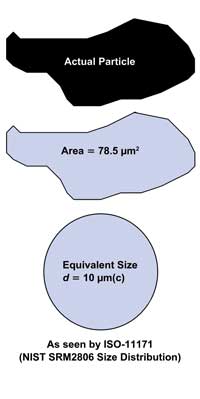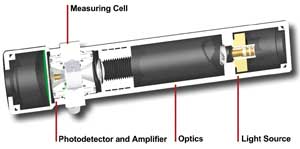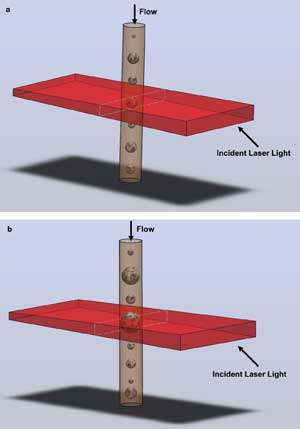Dr. Juliane König-Birk, Pamas GmbH
Particle contamination of fluids is a huge problem in a variety of applications. Pharmaceutical products, pure water, and hydraulic and lubricating oil and fuels, for example, have strict cleanliness standards and contamination limits. In open systems, dirt from outside could contaminate a liquid. But even in closed systems, pollution of the fluids due to abrasion of seals and tubes is possible.
Contamination with particles decreases the functionality of operating liquids, so these fluids should be kept clean to avoid damage. In most cases, nonconstant change intervals depending on the real contamination level are economically more efficient than fixed time intervals.
Optoelectronic sensors can count and classify particles related to their size. Depending on the particle size, light-extinction or light-scattering sensors can be used. In either case, laser light is shone through the liquid to be analyzed.
For hydraulic and lubricating oil and fuel applications, the sensors are calibrated with ISO Medium Test Dust (ISO-MTD) according to ISO 11171. Basically, due to the diffraction limit, light-extinction sensors cannot detect particles smaller than 3 µm(c). As the particles in such sensors are detected as two-dimensional shadows, the unit µm(c) is defined as the diameter of a circle disc with the same area as the real arbitrary-shaped shadow of the particle itself (Figure 1).

Figure 1. Particle size definition. d = diameter. Images courtesy of Pamas GmbH.
Light-scattering sensors are used for particles smaller than 3 µm(c). According to the unit µm(c), the particles can be seen as spherical objects for theoretical calculations. In 1908, Gustav Mie published his famous article about light scattering at colloidal particles. With the restriction of single and spherical particles, the Mie theory provides an exact solution of Maxwell’s equation for a plane electromagnetic wave scattered by these objects. Compared to the optical path in the sensor, the incident light is not a perfect plane wave.
But to get an estimate of the electromagnetic field outside the particles, one can apply the Mie theory. Depending on the polarization direction of the incident light, the spatial direction and the corresponding intensity of the scattered light vary. The maximum intensity, however, always travels in a forward direction for particle sizes down to 1.5 µm(c). Thus, the detection unit should be positioned in the direction of the incident light.
Laser diodes often are used as light sources in particle-counting sensors. In selecting the laser diode, there are various requirements to consider. For example, you will need an appropriate wavelength with a low absorption in the liquid to be analyzed. The advantages of laser diodes are good collimation, reliability, small size, availability and long lifetime. Because particle counters are used often in harsh environments, not only the light source but also the components must be rugged.
With various lenses, the light of the laser diode is focused into the measuring cell (Figure 2). Since the maximum particle concentration of the sensor depends on the illuminated volume, the optical path in the sensor is of prime importance.

Figure 2. Schematic design of a particle-counting sensor.
There are two types of sensors. One is a so-called in situ sensor. That means that only a part of the liquid is illuminated. For fluids with low particle concentration, the measuring result is affected by a huge statistical error, because not all particles are detected. The second is a sensor with a volumetric sensor cell, in which the whole measuring volume is illuminated by the laser light. So every particle is analyzed and counted. Even very clean fluids down to code 0/0/0 of the cleanliness standard ISO 4406 can be analyzed.
As measuring volume increases, the maximum particle concentration with an acceptable coincidence error decreases. Light-scattering sensors analyzing particles down to 1.5 µm(c) should have a maximum particle concentration of >10,000 p/ml at a coincidence error of 5 percent.
Coincidence occurs when two or more particles appear at the same time in the illuminated volume. If they are behind each other, only one particle is detected. If they are not, the scattered light of all particles is detected and, therefore, they are counted as one big particle. For that reason, the illuminated volume in the measuring cell should be as small as possible.
Resolution decreases with decreasing measuring volume. As shown in Figure 3, the incident laser light illuminates the whole particle only when the particle is small. As for a bigger particle, only a part of it scatters the light and contributes to the signal. The resolution is determined with mono-sized particles. In fact, there is a standard deviation of particle size. That means that in the signal response, there is no sharp peak like a delta function, but instead a bell-shaped curve. The resolution determines how well a given particle size with a known standard deviation is detected. In Figure 3, it is obvious that the resolution is dependent on the particle size for a given width of laser light shining on the fluid in the measuring cell. Therefore, the resolution has to be specified for a given particle size.

Figure 3. Resolution: (a) small particle, (b) big particle.
In the sensor’s optical path design, good resolution and high maximum particle concentration must be taken into account, and other parameters must be considered as well. In most cases, backreflection of laser light into the laser diode destroys the diode. Furthermore, reflected or scattered light from different surfaces creates background noise for the sensor’s detector as it detects the scattered light from the particles. To minimize reflection and noise, all optics should have an antireflection coating specified for the appropriate incidence angles of the laser light. High transmittance of the collector optic is vital, because of the small signal coming from the small particles.
If the signal is detected in a forward direction, an adequate light trap, capturing all the light coming directly from the laser diode, is required. The light trap must be placed in the optical path in such a way that the scattered light from the particles is not shadowed. A photodiode can be used as a detector. The photodiode and the processing electronics must be sensitive enough to detect the very small signals from the 1.5-µm(c) particles, and they have to be constructed such that the high signals from huge particles — 25 µm(c), for example – don’t drive the photodiode into saturation. Particles typically range in size from 1.5 to 25 µm(c).
Particle-counting sensors like the Pamas SLS-25/25 are powerful tools for contamination monitoring. In contrast to related methods such as turbidimetry, spectroscopy and microscopy, particle counting saves time analyzing single particles, and it detects particle size and number simultaneously and directly from the batch sample or online in the application, even in pressurized systems.
A specific application is in the filter industry. Performance is continuously improving in filters. The separation limit for fuel filters used to be about 4 µm(c). With new media, smaller sizes are achievable. To specify these filters, automatic particle counters detecting particle sizes below 4 µm(c) are required. Thus, with the technical innovation of a light-scattering sensor calibrated down to particle sizes of 1.5 µm(c), the automotive, filter, fuel and oil industries can continue to advance.
Meet the author
Dr. Juliane König-Birk develops optoelectronics at Pamas GmbH in Rutesheim, Germany; email: [email protected].